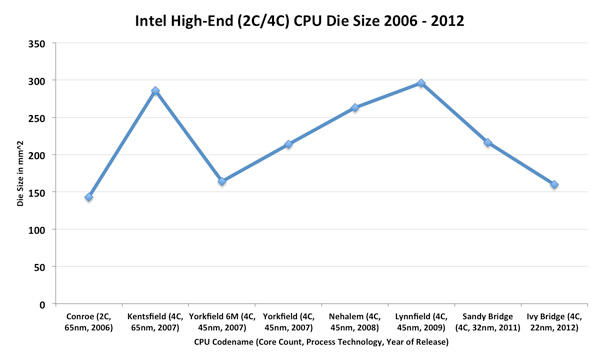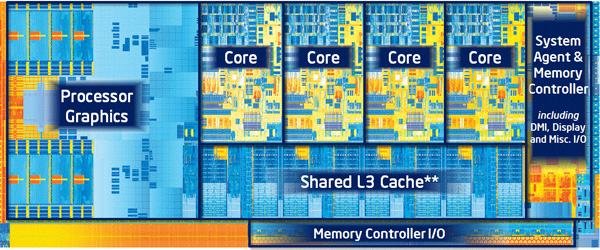The Intel Ivy Bridge (Core i7 3770K) Review
by Anand Lal Shimpi & Ryan Smith on April 23, 2012 12:03 PM EST- Posted in
- CPUs
- Intel
- Ivy Bridge
Die Size and Transistor Count
At IDF last year we got word of Ivy Bridge's transistor count (1.4 billion), however today we know its die size: 160mm2. That's 75% the size of a quad-core Sandy Bridge, but with 20% more transistors.
This marks the first time since 2006 that Intel is offering a high-end desktop CPU with this small of a die size. I'm excluding the 6-core parts from the discussion since that line isn't really aimed at the same market anymore. The chart is even more insane when you consider the Ivy Bridge die size includes an integrated GPU alongside four of the highest performance x86 cores Intel has ever shipped. Remove the GPU and Ivy Bridge is even smaller than Conroe. A hypothetical GPU-less Ivy Bridge would measure in at roughly 113mm^2 chip on its 22nm process, making it smaller than any high-end Intel CPU since the days of the Pentium 3.
| CPU Specification Comparison | ||||||||
| CPU | Manufacturing Process | Cores | Transistor Count | Die Size | ||||
| AMD Bulldozer 8C | 32nm | 8 | 1.2B | 315mm2 | ||||
| Intel Ivy Bridge 4C | 22nm | 4 | 1.4B | 160mm2 | ||||
| Intel Sandy Bridge E (6C) | 32nm | 6 | 2.27B | 435mm2 | ||||
| Intel Sandy Bridge E (4C) | 32nm | 4 | 1.27B | 294mm2 | ||||
| Intel Sandy Bridge 4C | 32nm | 4 | 1.16B | 216mm2 | ||||
| Intel Lynnfield 4C | 45nm | 4 | 774M | 296mm2 | ||||
| Intel Sandy Bridge 2C (GT1) | 32nm | 2 | 504M | 131mm2 | ||||
| Intel Sandy Bridge 2C (GT2) | 32nm | 2 | 624M | 149mm2 | ||||
Ivy Bridge is tiny—but what does this mean? For starters, it means the obvious—Intel has little competition in the desktop space. I'm always hard on AMD in my meetings with them because of this reason alone. A less than competitive AMD means we get a less aggressive Intel.
More importantly however, a tiny Ivy means that Intel could have given us a much bigger GPU without breaking the bank. I hinted at this possibility in our Ivy Bridge architecture article. Unfortunately at the time only Apple was interested in a hypothetical Ivy Bridge GT3 and rumor has it that Otellini wasn't willing to make a part that only one OEM would buy in large quantities. We will eventually get the GPU that Apple wanted, but it'll be next year, with Haswell GT3. And the GPU that Apple really really wanted? That'll be GT4, with Broadwell in 2014.
All of this being said however, we must keep in mind that Ivy Bridge is both faster than Sandy Bridge and no more expensive. If we look at the supply and pricing constraints that accompany TSMC's 28nm process, the fact that Intel is able to ramp up 22nm and ship the first products without any price increase is something we shouldn't take for granted.












173 Comments
View All Comments
sld - Wednesday, April 25, 2012 - link
.... and in this multivariate comparison you choose to ignore the superior battery life which makes Llano a serious competitor in the mobile space.midn8t - Thursday, June 28, 2012 - link
this the frames pre secound for CPU, you cant really figure out well when gamming its all mostly based around what ever video card they used, in this artical so I would have to guess that they might have used diffrent GPU video card in each system.obivuously they cant use same motherboard for amd vs intel
Also I find it wired that other reciews have Rated the phenom II x6 lower in preformance then the FX chip makes it wired how these review claims that the phenom II which is lower grade CPU is more powerfull then the top of the line AMD product out.
zeagus - Wednesday, April 25, 2012 - link
A huge chunk of text is spent explaining how while its a step in the right direction, they need to do more on the GPU side of the equation. Take off your strangely coloured glasses.wingless - Monday, April 23, 2012 - link
EDIT: I'M NOT KIDDING. I bought my 2600K the Friday before last for $199 and paired it with an ASUS P8Z77-V PRO. Ivy Bridge is simply too hot and lacks OC performance.I overclock so I WILL be keeping my 2600K for the foreseeable future!
fredisdead - Sunday, April 29, 2012 - link
So HD4000 igp is weaker than last gen Brazos ?? Based on the leaked Trinity benchmarks, Trinity blows any Intel igp into the weeds, never mind the ( already 1.5 yr old ) Brazos, which is 'only' 5% faster.fredisdead - Sunday, April 29, 2012 - link
So HD4000 igp is weaker than last gen Brazos ?? Based on the leaked Trinity benchmarks, Trinity blows any Intel igp into the weeds, never mind the ( already 1.5 yr old ) Brazos, which is 'only' 5% faster.1ceTr0n - Monday, April 23, 2012 - link
I'll keep my 2500k @ 4.6ghzNot kidding
smookyolo - Monday, April 23, 2012 - link
And I'll keep mine at 4.9GHz.But that's just because I'll be waiting for the tock, not the tick.
I will however be getting a Ivy Bridge Laptop soon.
Flunk - Monday, April 23, 2012 - link
Me too, the 2500K is a great chip. Especially with watercooling.Ratman6161 - Monday, April 23, 2012 - link
For anyone like me who already has a Sandy Bridge quad core (mine's a 2600K) it wouldn't make a lot of sense to "upgrade" to an Ivy bridge. But for those with older systems looking to upgrade, these actually seem like pretty good deals. @ $313 the 3770K is cheaper than the 2700K and cheaper than the typical price on a 2600K (unless like me you are lucky enough to live near a Micro Center).As to those complaining about graphics, come on. Will anyone who really cares a lot about graphics, particularly gaming, be using the on board graphics anyway?